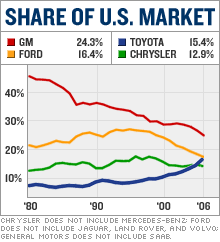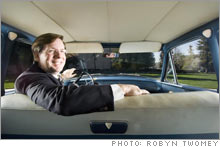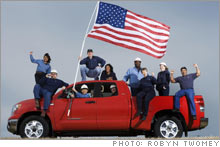America's best car companyToyota has become a red-white-and-blue role model. How? By understanding Americans better than Detroit does.(FORTUNE Magazine) -- Two Tinny sedans left the port of Yokohama in August 1957, bound for California - the first exports from Toyota. The four-door clunkers flopped. The car, which looked like a brick with a roof on top, was prone to overheating and vibrated at speeds of more than 60 miles per hour. By late 1960, Toyota realized it had made a mistake and pulled the Toyopet Crown off the market. A less determined company might never have returned after this humiliation. But Toyota (Charts) came back a few years later with a better car and has gone from strength to strength ever since.

The world's most profitable automaker - and soon to be its biggest - now has a 15% market share in the U.S., where it sold 2.5 million cars and trucks last year. Because Toyota is already bigger than Chrysler in the U.S. and is about to pass Ford, Automotive News, the industry bible, has retired the "Big Three" moniker; GM (Charts), Ford (Charts), and Chrysler (Charts) will henceforth be known as the Detroit Three. Toyota's presence in the U.S. is now so routine that the 3,322 business leaders Fortune surveyed named Toyota one of America's Most Admired Companies for the second year in a row - boosting it to third place overall, behind two American perennials, General Electric and Starbucks. Toyota has returned the compliment, making an entrance into that most American of sports - we're talking NASCAR - and introducing a full-sized, Texas-built pickup truck, the Tundra. As the story of the tarnished Crown hints, nothing was inevitable about Toyota's success. It has managed to survive discriminatory taxes, import restraints, and the occasional xenophobic hissy fit - U.S. workers taking sledgehammers to imported cars - to become something of a model citizen. There's no question that coming in fresh, Toyota had some advantages over Detroit: It was unburdened by retiree obligations, union contracts that had been bid up over decades, and brands like Oldsmobile that refused to make money (or die). And yes, it was lucky to have small cars ready to sell when the first oil shocks hit in the 1970s. But the most important reason that Toyota became America's most prestigious automaker is that this quintessentially Japanese company has been better than Detroit at reading the American car psyche. Toyota has never been a style leader. It has never created a car as iconic as, say, the Ford Mustang. But it discerned correctly that many car buyers don't need the next hot thing. They just want a trouble-free product that looks fine - and they will pay a premium for it. One way Toyota reads the public mind is the think tank at Toyota Motor Sales in Torrance, Calif., where a research department staffed by 116 people monitors the industry and keeps tabs on demographic and economic developments. Its mission: to predict consumer trends and create a lineup of cars and trucks to capitalize on them. Each professional is expected to spend time out in the field talking to car buyers. The Japanese have a name for it: genchi genbutsu - go to the scene and confirm the actual happenings. Most big companies have something like it; what distinguishes Toyota is that its executives actually listen and have turned those insights into profits. When researchers found in the mid-1990s that Toyota was losing young buyers to hipper brands like VW, its marketers dreamed up the hugely successful Scion. Another case: GM was fooling around with electric cars as far back as the 1980s, but it was Toyota that tapped into the appeal of the green revolution with the hybrid-powered Prius. The Prius accounts for less than 5% of U.S. sales, but Toyota has won a fortune in good publicity. The in-the-flesh manifestation of this obsession with research and planning is Jim Lentz, 51, who succeeded Jim Press (see "Toyota's Secret Weapon") last year as the top American executive at Toyota's U.S. sales arm. Preppy and personable, Lentz peppers his conversation with trend-conscious facts (did you know that Wal-Mart intends to sell 400 kinds of organic food?) and watches the rest of the world nearly as closely as he does the U.S. (he marvels at the explosion of premium-priced small cars in Europe, like the BMW 1-series). Toyota is tilting toward American tastes today - that's what the Tundra and the dip into NASCAR racing are about - but he expects to be taking a broader perspective over the next ten years. "The landscape of the market is going to change dramatically," he said during an interview at Toyota's campus south of Los Angeles. "Urbanization, interest in healthy lifestyles, safety, and security--we need to open our eyes to more global products and platforms." That's positive for a small car like Toyota's Yaris, which can be sold around the world, but less so for the U.S.-only Tundra, a V-8 that gets about 16 miles per gallon. The new Tundra is an inflection point for Toyota in the U.S. On the one hand, Lentz has to figure out how to make it succeed in the auto market of the future; on the other, it's a big investment that needs to succeed right away. Inside the company it's common to hear the Tundra described as the riskiest launch in its history, because it is highly visible - and frankly, a test of the company's machismo. Toyota has high expectations: more than 200,000 truck sales this year (nearly twice that of the previous smaller model), 300,000 eventually. It's a direct challenge to Motown. Full-sized pickups are the highest-volume vehicles sold by the Detroit Three and make a tidy profit. Buyers are loyal, and imports have had a tough time breaking in. Toyota approached the new Tundra cautiously - and characteristically. Planning started seven years ago, when engineers gathered in 2000 to drive different trucks and experiment with hauling trailers - a weakness in the old version. They even stopped at national parks to talk to recreational users. Such nitty-gritty consumer study, bolstered by other research, told Toyota it should stay away from cowboy imagery and country music; the competition had covered that territory. "Buyers said, 'Don't waste our time. Tell me why I should buy the truck,'" Lentz says. The upshot: Emphasize brute strength and performance. During the Super Bowl, Toyota did just that. One ad for the Tundra showed it hauling a 10,000-pound load; another depicted it braking inches before it hurtled off a precipice (the truck was restrained by a tether). To show that it was serious, Toyota decided to build a brand-new plant dedicated to this model in San Antonio. Far from normal transportation routes, the location is difficult logistically, but it did plop Toyota in the heart of truck country - and in a big, powerful state. |
Sponsors
|




